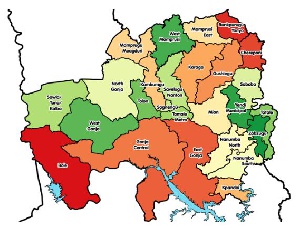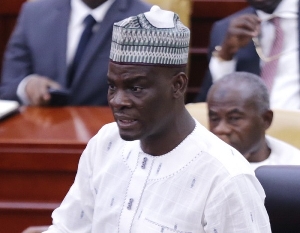Opinions of Wednesday, 18 January 2023
Columnist: Abdul-Karim Mohammed Awaf
Deconstructing Northern Ghana; Why it is so Wealthy yet Impoverished
Five regions constitute the savannah enclave of Ghana which is often referred to as the north, home to more than 30 ethnic groups but often treated as a homogeneous bloc because of the north-south divide. Interestingly, there are people from the south who erroneously think that all people from the north speak the same language.
Growing up in the south, there was this standing joke that a lady from the south brought her suitor home to meet her parents. Upon inquiry, the lady’s mother got to know that the guy hailed from the north so she objected to the marriage. Her excuse was that the “North” was too far and therefore it would be difficult for them to attend social gatherings like funerals in the event of bereavement.
As an obedient daughter, the lady had to give in to her mother’s demands and quit the relationship as painful and disappointing as it might be.
Then as time went by, the lady one day told her mother that she had met another man but unfortunately this gentleman is a white man who lives far away in America, and since she (the mother) is not keen on her getting married to someone who lives in a faraway place, she rejected his proposal.
Before she could end her last words, her mother held his head and screamed with loud disappointment, “I said the north of Ghana is far, I didn’t say America.”
Just like Joseph Conrad describes Africa as “…so hopeless and so dark…”, in his novel, ‘Hearts of Darkness’ so do many people from the southern part of Ghana perceive the north.
This image of the North is bolstered by two major factors. The first reason is the migration of young girls (even children) from the north to the major cities in the south to engage in kayaye.
Another is the frequent news about ethnic conflicts in some parts of the five northern regions.
Conflict and poverty are like Siamese twins, they go hand in hand. When it comes to northern Ghana, however, these two factors were purposely created by the British colonial administration. For instance, when the people of the south had their first secondary school, it took another 75 years for the whole of the five northern regions to get their first secondary school.
The unbridled conflict in some places of the north is also a result of the unintended consequences of indirect rule which was introduced by the British. Literature abounds about how the British colonial administration co-opted chiefs from parts of the north that had established chieftaincy systems and imposed them on areas that did not have chieftaincy institutions, in the quest to implement British indirect rule policy.
The subsequent failure by the British colonial administration to correct this anomaly before handing over the administration of the country to Ghanaians after independence created many of the conflicts we still see today. While those who had chiefs imposed on them, now want to rule themselves after independence, those who were made chiefs (courtesy of the British) over rightful owners still want to continue to lord over the indigenous people. Hence, the seemingly unending conflict.
Another front that the colonial administration deprived the north of is infrastructural development. The rail system and other critical infrastructure were all concentrated in the south. For instance, a person in the north who has never come to the south has probably never seen a train or even a rail track before.
In the post-colonial era, successive governments paid very little attention to the north. In 2016, when I traveled to Bawku in the Upper East Region, I was shocked to see that a major road linking the regional capital of the Upper East Region, Bolgatanga, to a municipal town like Bawku which is also the gateway to Ghana from the northern corridor, was in a bad state while a small town like Bepoase in the Sekyere South District of the Ashanti Region (for comparison purposes only) had all its inner roads tarred.
The north is also lagging as a result of the greed of some of our people. When the erstwhile NDC government implemented the Savannah Accelerated Development Authority (SADA), our northern elites were at the forefront of this initiative but sadly they mismanaged it leading to its collapse.
Also, despite the enormous wealth of some northerners, they have often decided to invest in the south instead of investing in the north to create economic opportunities for the youth.
There is also a lot of untapped potential in the north. For instance, the entire savanna ecosystem is blessed with shea trees, from which we get shea butter. According to Bloomberg report the size of the Global Shea Butter Market was estimated to be USD 2.48 Billion in 2021 and to increase to USD 4.15 Billion by 2028, with a forecasted CAGR of 7.60%.
Despite the boom in the shea trade as a result of global demand for Shea butter products such as lip balm, soap bars, body lotion, moisturizers, hair conditioners, confectionery industry for manufacturing chocolates, etc., people from the north have not benefited much from this commodity.
Unlike cocoa prices being regulated by the government, the shea industry has been left in the hands of foreign firms and so-called benevolent NGOs who buy the products at cheaper prices to the impoverishment of the local people. Many shea trees are, as a result of this, being felled for the production of charcoal because of the low price of shea nuts.
Another commodity from the north which has not seen much attention is soybeans regarded as “the king of beans”. Much of the savannah enclave is good for the production of soybeans. Soybeans is the most popular plant-based protein source.
According to the 2020 global market study of the International Institute for Sustainable Development (IISD), 150.1 million metric tons of soybeans worth $58 billion were shipped in 2017. It was also estimated that the sector’s overall (retail) market value was around $146 billion.
Despite this, the people of the north have not been able to maximize production because of soybean and other crops because of factors such as poor road networks, lack of irrigation dams, and high cost of farm inputs, among others. The One Village, One Dam campaign promise was taunted to be a game changer to enhance agricultural production in that part of the country, however, it has turned out to be a failure. The construction of the Pwalugu Multipurpose Dam is also at a snail's pace due to the starvation of funds.
These factors collectively contribute to the deprivation of the north.
To bridge the gap between the north and south, governments need to stop paying lip service to the north and urgently invest in critical areas in the north such as agriculture, mining, and human capital development.
Just like the south, the north is well-endowed only that it has been neglected













